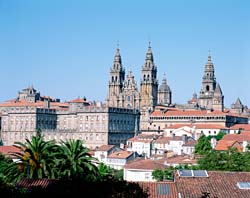 Northern Spain and Galicia particularly has long been an undiscovered jewel in the whole of the Spanish tourism industry. Whereas elsewhere in the Iberian Peninsula the climate can be quite continental and extreme, in the northwest and on the coast the climate is as you would expect much milder and more of a maritime nature.
Northern Spain and Galicia particularly has long been an undiscovered jewel in the whole of the Spanish tourism industry. Whereas elsewhere in the Iberian Peninsula the climate can be quite continental and extreme, in the northwest and on the coast the climate is as you would expect much milder and more of a maritime nature.
The Galician coastline boasts two different features in that in certain places it is extremely rugged and in others it can boast some of the most beautiful beaches in Spain. Overall of all of the autonomous regions of Spain possibly Galicia is the most remote.
Galicia is a region of contrasts in that in the one extreme you have a rugged beautiful coastline mixed with gorgeous beaches whilst inland you have beautiful mountain scenery. The region is famous for its excellent cuisine and boasts one of the most visited religious pilgrimage sites in Western Europe after the Vatican in Santiago de Compostela. Such is the nature of the pilgrimage site at Santiago de Compostela that it appears to have inspired a tourism industry of its own.
The Galicians, whose origins are Celtic, are fiercely proud of their culture and language. Traditionally, Galicia was seen as a poor agricultural region, whose economy did not lend itself to modernisation. Galicia always seemed to be a very closed and inward looking area being fiercely resistant to any formal external invasion. Apart from a brief interlude in the 11th and 10th centuries when Galicia fell briefly under the rule of the kingdom of Asturias, Galicia has always been an independent region.
One of the problems with Galicia as with some of the other remote communities in Western Europe lies within its geographical constraints. The result of this was that Galicia became very much like its Celtic cousins in the north such as Ireland and became a source of many waves of emigration. Thankfully slowly throughout the 20th century Galicia has begun to develop a way in which to manage the traditional lifestyles with a modern community to ensure that none of its rich history is lost.
As you can imagine from a region where the coast plays such an important part, the major communities and cities lie on the coast at Vigo and Corunna. Fishing is vital to the economy of Galicia and it’s seafood is amongst the best in Spain. The small fishing villages dot the entire coastline. Galicia and its coastline like other parts of the Atlantic Coast was devastated in 2002 with the sinking of the oil tanker prestige however the coastline has appeared to make an outstanding comeback with a tremendous recovery and in some cases is almost as good as new.
Cape Finisterre, the most westerly part of the Spanish mainland is part of the Galician coast. Throughout the region especially in the hills are concealed many remains of ancient Celtic settlement's, quite often especially up in the hills, these are often shrouded in mist. Other examples of the Celtic traditions can be found in the many stone crosses found at crossroads and junctions throughout the region whilst also the continued use of the old traditional stone granaries found in many villages.
As with other Celtic regions, the love of music and the arts is very common in Galicia and as well as its own traditional language, Gallego, Galicia has its traditional musical instrument the bagpipes! There are a great many similarities between Galicia and the other Celtic Countries and nowhere is this more evident with Art and Culture. With respect to the Galicians, there is a certain Melancholy to their traditional songs and poetry and this too they have in common with the Irish, Breton, Scottish, Welsh and other Celts. With regards to Galicia (as with County Donegal in the Republic of Ireland), as anyone who has experienced some of the fierce storms coming in from the Atlantic perhaps this is understandable.
Comments:
| Comment | Date | User |
| If you want to see the art made in galicia, you can watch it from your home in http://www.artgalicia.com | 6/11/2011 9:56:00 AM | pablo |